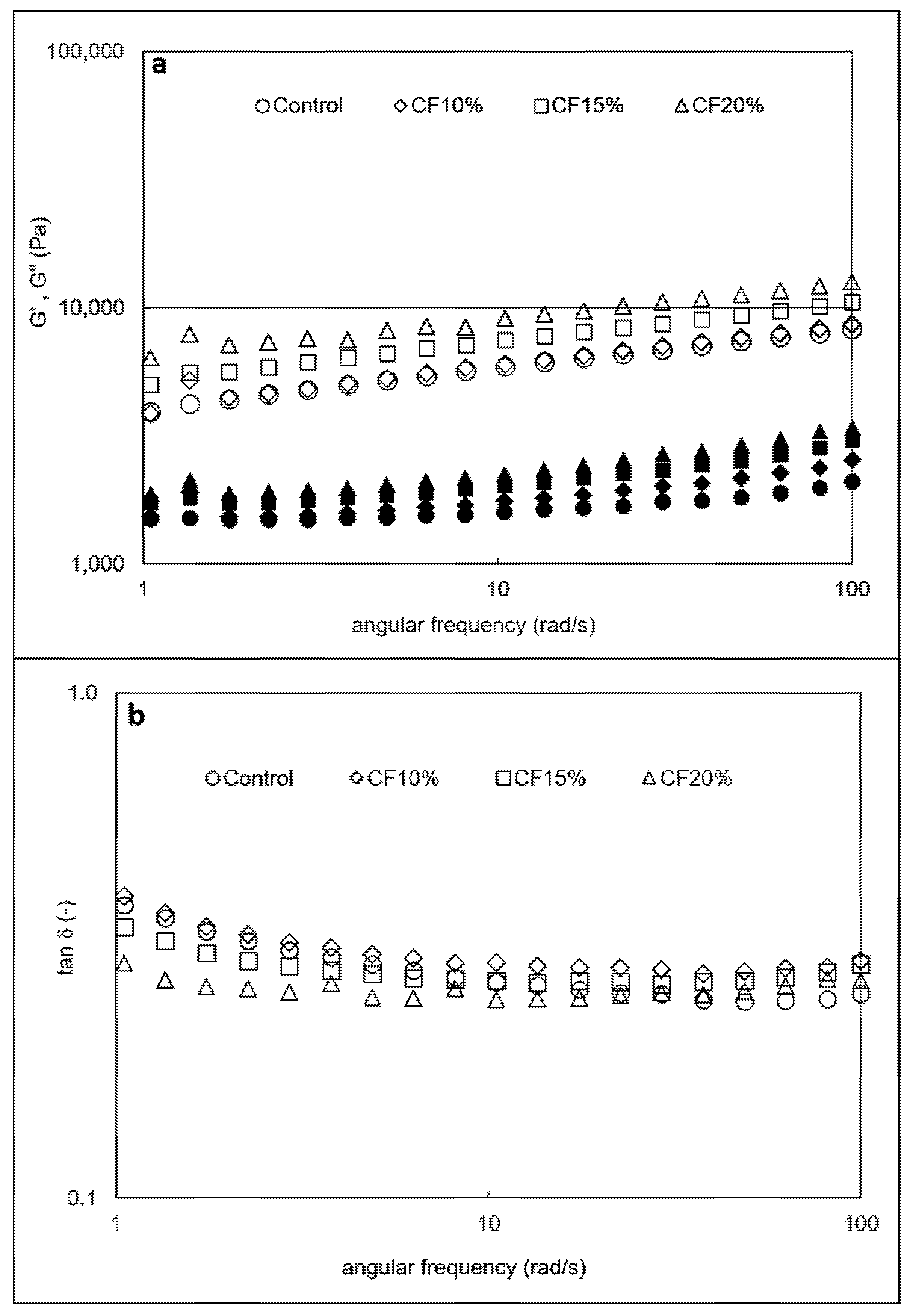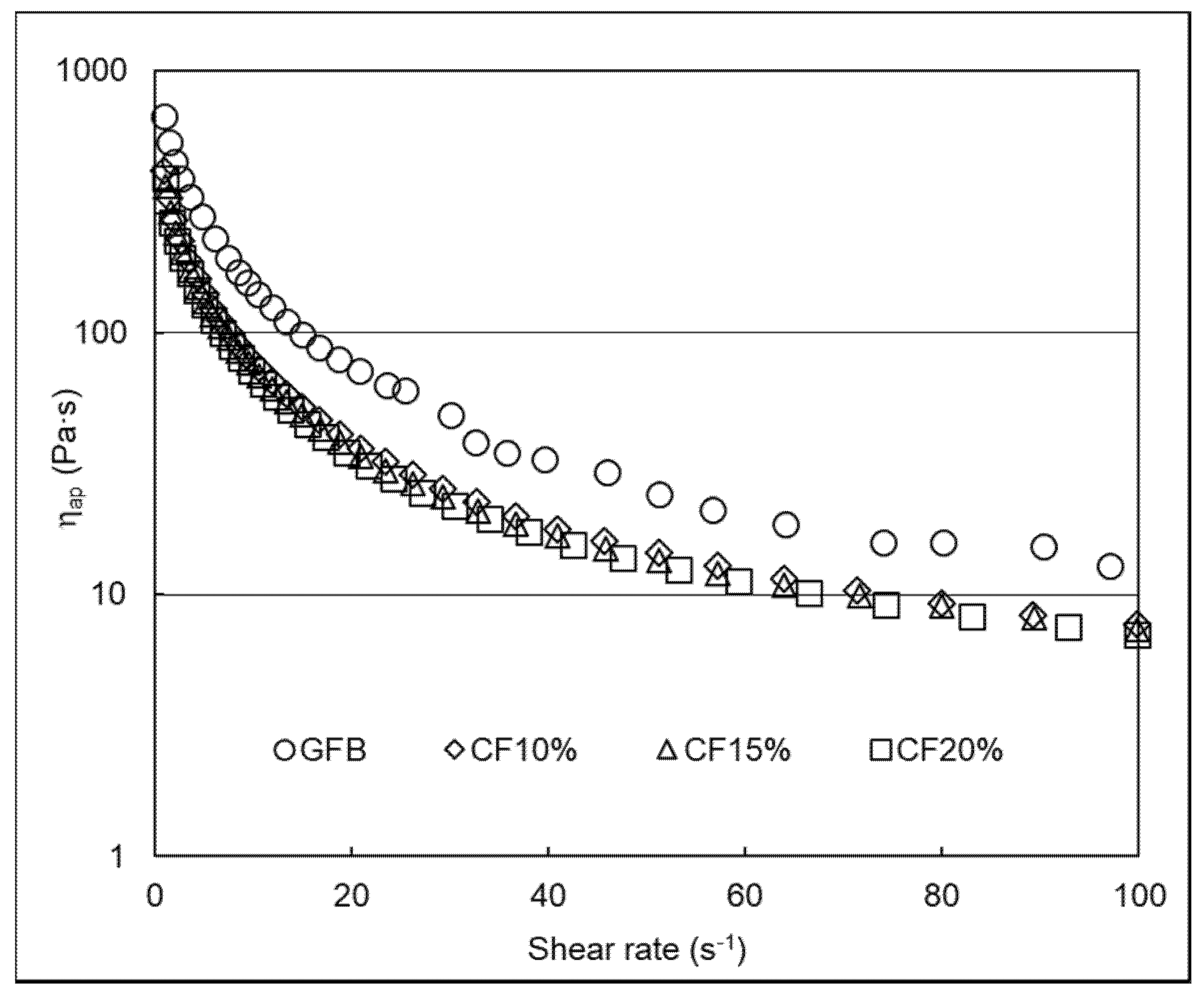Effect of Citrus Fiber on the Rheological Properties of Dough and Quality of the Gluten-Free Bread
Abstract
1. Introduction
2. Materials and Methods
2.1. Materials
2.2. Methods
2.2.1. Gluten-Free Bread Formulation
2.2.2. Rheological Properties of the Dough
2.2.3. Dough Preparation and Baking
2.2.4. Bread Analysis
2.2.5. Statistical Analysis
3. Results and Discussion
3.1. Rheological Properties of Dough
3.2. Bread Characteristics
3.3. Crumb Texture
4. Conclusions
Author Contributions
Funding
Conflicts of Interest
References
- Kołodziejczyk, P.; Michniewicz, J. Cereal grains and cereal products as sources of dietary fibre. Food Sci. Technol. Qual. 2018, 116, 5–22. [Google Scholar] [CrossRef]
- Sajdakowska, M.; Jeżewska-Zychowicz, M. Consumer attitudes towards bread and perception of bread with added fibre. Food Sci. Technol. Qual. 2017, 113, 113–125. [Google Scholar] [CrossRef]
- Godula, K.; Czerniejewska-Surma, B.; Dmytrów, I.; Plust, D.; Surma, O. Possible applications of dietary fibre in functional food production. Food Sci. Technol. Qual. 2019, 119, 5–17. [Google Scholar] [CrossRef]
- Witczak, T.; Juszczak, L.; Ziobro, R.; Korus, J. Rheology of gluten-free dough and physical characteristics of bread with potato protein. J. Food Process Eng. 2017, 40, e12491. [Google Scholar] [CrossRef]
- Witczak, M.; Korus, J.; Ziobro, R.; Juszczak, L. Waxy starch as dough component and anti-staling agent in gluten-free bread. LWT Food Sci. Technol. 2019, 99, 476–482. [Google Scholar] [CrossRef]
- Matos Segura, M.E.; Rosell, C.M. Chemical composition and starch digestibility of different gluten-free breads. Plant Food. Hum. Nutr. 2011, 66, 224. [Google Scholar] [CrossRef]
- Hager, A.S.; Axel, C.; Arend, E.K. Status of carbohydrates and dietary fiber in gluten-free diets. CFW 2011, 56, 109–114. [Google Scholar] [CrossRef]
- Melini, F.; Melini, V.; Luziatelli, F.; Ruzzi, M. Current and forward-looking approaches to technological and nutritional improvements of gluten-free bread with legume flours: A critical review. Compr. Rev. Food Sci. Food Saf. 2017, 16, 1101–1122. [Google Scholar] [CrossRef]
- Naqash, F.; Gani, A.; Gani, A.; Masoodi, F.A. Gluten-free baking: Combating the challenges—A review. Trends Food Sci. Technol. 2017, 66, 98–107. [Google Scholar] [CrossRef]
- Khoury, D.E.; Balfour-Ducharme, S.; Joye, I.J. A review on the gluten-free diet: Technological and nutritional challenges. Nutrients 2018, 10, 1410. [Google Scholar] [CrossRef]
- Korus, J.; Witczak, M.; Ziobro, R.; Juszczak, L. The influence of acorn flour on rheological properties of gluten-free dough and physical characteristics of the bread. Eur. Food Res. Technol. 2015, 240, 1135–1143. [Google Scholar] [CrossRef]
- Korus, J.; Witczak, M.; Ziobro, R.; Juszczak, L. Hemp (Cannabis sativa subsp. sativa) flour and protein preparation as natural nutrients and structure forming agents in starch based gluten-free bread. LWT Food Sci. Technol. 2017, 84, 143–150. [Google Scholar] [CrossRef]
- Korus, J.; Achremowicz, B. Fiber preparations of different origin used as additives in baking gluten-free breads. Food. Sci. Technol. Qual. 2004, 38, 65–73. [Google Scholar]
- Aprodu, I.; Banu, I. Influence of dietary fiber, water, and glucose oxidase on rheological and baking properties of maize based gluten-free bread. Food. Sci. Biotechnol. 2015, 24, 1301–1307. [Google Scholar] [CrossRef]
- Ronda, F.; Perez-Quirce, S.; Lazaridou, A.; Biliaderis, C.G. Effect of barley and oat β-glucan concentrates on gluten-free rice-based doughs and bread characteristics. Food Hydrocolloids 2015, 48, 197–207. [Google Scholar] [CrossRef]
- Martínez, M.M.; Díaz, Á.; Gómez, M. Effect of different microstructural features of soluble and insoluble fibres on gluten-free dough rheology and bread-making. J. Food Eng. 2014, 142, 49–56. [Google Scholar] [CrossRef]
- Phimolsiripol, Y.; Mukprasirt, A.; Schoenlechner, R. Quality improvement of rice-based gluten-free bread using different dietary fibre fractions of rice bran. J. Cereal Sci. 2012, 56, 389–395. [Google Scholar] [CrossRef]
- Garcia-Amezquita, L.E.; Tejada-Ortigoza, V.; Serna-Saldivar, S.O.; Welti-Chanes, J. Dietary fiber concentrates from fruit and vegetable by-products: Processing, modification, and application as functional ingredients. Food Bioprocess Technol. 2018, 11, 1439–1463. [Google Scholar] [CrossRef]
- Fernández-López, J.; Fernández-Ginés, J.M.; Aleson-Carbonell, L.; Sendra, E.; Sayas-Barberá, E.; Pérez-Alvarez, J.A. Application of functional citrus by-products to meat products. Trends in Food Sci. Technol. 2004, 15, 176–185. [Google Scholar] [CrossRef]
- Larrea, M.A.; Chang, Y.K.; Martinez-Bustos, F. Some functional properties of extruded orange pulp and its effect on the quality of cookies. LWT Food Sci. Technol. 2005, 38, 213–220. [Google Scholar] [CrossRef]
- Kohajdová, Z.; Karovicová, J.; Jurasová, M.; Kukurová, K. Application of citrus dietary fibre preparations in biscuit production. J. Food Nutr. Res. 2011, 50, 182–190. [Google Scholar]
- Romero-Lopez, M.R.; Osorio-Diaz, P.; Bello-Perez, L.A.; Tovar, J.; Bernardino-Nicanor, A. Fiber concentrate from orange (Citrus sinensis, L.) bagase: Characterization and application as bakery product ingredient. Int. J. Mol. Sci. 2011, 12, 2174–2186. [Google Scholar] [CrossRef] [PubMed]
- Talens, C.; Álvarez-Sabatel, S.; Rios, Y.; Rodríguez, R. Effect of a new microwave-dried orange fibre ingredient vs. a commercial citrus fibre on texture and sensory properties of gluten-free muffins. Innov. Food Sci. Emerg. Technol. 2017, 44, 83–88. [Google Scholar] [CrossRef]
- Miller, R.A. Increased Yield of Bread Containing Citrus Peel Fiber. Cereal Chem. 2011, 88, 174–178. [Google Scholar] [CrossRef]
- Ocen, D.; Xu, X. Effect of citrus orange (Citrus sinensis) by-product dietary fiber preparations on the quality characteristics of frozen dough bread. Am. J. Food Technol. 2013, 8, 43–53. [Google Scholar] [CrossRef]
- O’Shea, N.; Doran, L.; Auty, M.; Arendt, E.; Gallagher, E. The rheology, microstructure and sensory characteristics of a gluten-free bread formulation enhanced with orange pomace. Food Funct. 2013, 4, 1856. [Google Scholar] [CrossRef]
- O’Shea, N.; Rößle, C.; Arendt, E.; Gallagher, E. Modelling the effects of orange pomace using response surface design for gluten-free bread baking. Food Chem. 2015, 166, 223–230. [Google Scholar] [CrossRef]
- Ozturk, O.K.; Mert, B. The use of microfluidization for the production of xanthan and citrus fiber based gluten-free corn breads. LWT Food Sci. Technol. 2018, 96, 34–41. [Google Scholar] [CrossRef]
- Föste, M.; Verheyen, C.; Jekle, M.; Becker, T. Fibres of milling and fruit processing by-products in gluten-free bread making: A review of hydration properties, dough formation and quality-improving strategies. Food Chem. 2020, 306, 125451. [Google Scholar] [CrossRef]
- Arslan, M.; Rakha, A.; Xiaobo, Z.; Mahmood, M.A. Complimenting gluten free bakery products with dietary fiber: Opportunities and constraints. Trends Food Sci. Technol. 2019, 83, 194–202. [Google Scholar] [CrossRef]
- Korus, J.; Witczak, M.; Ziobro, R.; Juszczak, L. The impact of resistant starch on characteristics of gluten-free dough and bread. Food Hydrocolloids 2009, 23, 988–995. [Google Scholar] [CrossRef]




| Parameter | Control GFB | 10% CF | 15% CF | 20% CF |
|---|---|---|---|---|
| K′ (Pa·sn′) | 4017.0 ± 138.4 a | 4024.1 ± 489.0 a | 5156.7 ± 411.8 b | 6503.5 ± 492.1c |
| n′(-) | 0.158 ± 0.003 b,c | 0.166 ± 0.006 c | 0.154 ± 0.001 b | 0.142 ± 0.006 a |
| r2> | 0.996 | 0.995 | 0.996 | 0.994 |
| K″ (Pa·sn”) | 1385.6 ± 51.3 a | 1382.7 ± 138.4 a | 1557.2 ± 125.4 a,b | 1687.4 ± 140.4 b |
| n” (-) | 0.071 ± 0.004 a | 0.114 ± 0.003 b | 0.125 ± 0.004 c | 0.139 ± 0.007 d |
| r2> | 0.858 | 0.938 | 0.940 | 0.939 |
| TanδTM at 1 Hz | 0.380 ± 0.004 c | 0.396 ± 0.008 d | 0.344 ± 0.007 b | 0.292 ± 0.002 a |
| J0 104 (Pa−1) | 3.40 ± 0.23 b | 2.96 ± 0.17 b | 2.04 ± 0.18 a | 1.66 ± 0.11 a |
| η0 (KPa·s) | 286.1 ± 11.5 a | 536.5 ± 61.5 a | 1135.1 ± 98.5 b | 1751.0 ± 107.5 c |
| J1 104 (Pa−1) | 4.55 ± 0.21c | 3.69 ± 0.31 b | 1.98 ± 0.23 a | 1.42 ± 0.21 a |
| λret (s) | 71.8 ± 0.9 a | 70.7 ± 1.7 a | 67.8 ± 6.1 a | 64.8 ± 5.4 a |
| r2> R (%) | 0.991 65.38 | 0.993 75.74 | 0.994 76.43 | 0.995 88.51 |
| K (Pa·sn) | 702.1 ± 8.6 a | 428.0 ± 28.8 b | 413.7 ± 14.8 b | 391.3 ± 31.0 b |
| n (-) | 0.312 ± 0.009 c | 0.264 ± 0.005 b | 0.249 ± 0.003 a | 0.257 ± 0.011 a,b |
| r2> | 0.996 | 0.995 | 0.996 | 0.994 |
| Sample | Volume (cm3) | Porosity (-) | Cell Density (cm−2) | Average Pore Size (mm2) |
|---|---|---|---|---|
| Control GFB | 135.8 ± 6.7 c | 0.416 ± 0.009 a | 49.4 ± 2.4 d | 0.84 ± 0.06 a |
| 10% CF | 110.0 ± 6.3 b | 0.431 ± 0.007 a,b | 38.1 ± 1.4 c | 1.13 ± 0.07 a,b |
| 15% CF | 98.3 ± 4.1 a | 0.436 ± 0.007 b | 32.6 ± 2.2 b | 1.37 ± 0.15 b,c |
| 20% CF | 95.0 ± 5.5 a | 0.455 ± 0.018 c | 29.5 ± 0.8 a | 1.56 ± 0.37 c |
| Sample | Day | Hardness (N) | Springiness- | Cohesiveness- | Chewiness (N) |
|---|---|---|---|---|---|
| Control GFB | 1 | 1.12 ± 0.11 b | 1.00 ± 0.00 d | 0.90 ± 0.00 g | 1.40 ± 0.26 c |
| 2 | 5.57 ± 0.99 f | 0.98 ± 0.01 c | 0.63 ± 0.03 e | 3.14 ± 0.48 g,h | |
| 3 | 7.42 ± 0.54 g | 0.97 ± 0.01 b,c | 0.52 ± 0.01 b | 3.80 ± 0.26 h | |
| 10% CF | 1 | 1.08 ± 0.05 b | 1.00 ± 0.00 d | 0.88 ± 0.03 g | 1.11 ± 0.09 b |
| 2 | 3.39 ± 0.22 d,e | 0.97 ± 0.01 c | 0.62 ± 0.04 d,e | 2.09 ± 0.21 e,f | |
| 3 | 5.45 ± 1.04 f | 0.96 ± 0.01 b | 0.50 ± 0.02 a,b | 2.59 ± 0.39 f,g | |
| 15% CF | 1 | 1.04 ± 0.03 b | 1.00 ± 0.00 d | 0.85 ± 0.03 f | 0.94 ± 0.05 a |
| 2 | 3.00 ± 0.42 c,d | 0.96 ± 0.01 b | 0.58 ± 0.03 c,d | 1.62 ± 0.23 c,d | |
| 3 | 4.06 ± 0.22 e | 0.94 ± 0.02 a | 0.47 ± 0.03 a | 2.01 ± 0.24 e | |
| 20% CF | 1 | 0.88 ± 0.06 a | 1.00 ± 0.00 d | 0.82 ± 0.01 f | 0.91 ± 0.05 a |
| 2 | 2.64 ± 0.31 c | 0.94 ± 0.02 a | 0.56 ± 0.03 c | 1.53 ± 0.20 c,d | |
| 3 | 3.94 ± 0.83 e | 0.93 ± 0.02 a | 0.46 ± 0.03 a | 1.91 ± 0.49 d,e | |
| Two-way ANOVA-p | |||||
| Factor A (level of additive) | <0.001 | <0.001 | <0.001 | <0.001 | |
| Factor B (time) | <0.001 | <0.001 | <0.001 | <0.001 | |
| Factor A × Factor B | 0.014 | 0.005 | 0.798 | 0.909 | |
© 2020 by the authors. Licensee MDPI, Basel, Switzerland. This article is an open access article distributed under the terms and conditions of the Creative Commons Attribution (CC BY) license (http://creativecommons.org/licenses/by/4.0/).
Share and Cite
Korus, J.; Juszczak, L.; Witczak, M.; Ziobro, R. Effect of Citrus Fiber on the Rheological Properties of Dough and Quality of the Gluten-Free Bread. Appl. Sci. 2020, 10, 6633. https://doi.org/10.3390/app10196633
Korus J, Juszczak L, Witczak M, Ziobro R. Effect of Citrus Fiber on the Rheological Properties of Dough and Quality of the Gluten-Free Bread. Applied Sciences. 2020; 10(19):6633. https://doi.org/10.3390/app10196633
Chicago/Turabian StyleKorus, Jarosław, Lesław Juszczak, Mariusz Witczak, and Rafał Ziobro. 2020. "Effect of Citrus Fiber on the Rheological Properties of Dough and Quality of the Gluten-Free Bread" Applied Sciences 10, no. 19: 6633. https://doi.org/10.3390/app10196633
APA StyleKorus, J., Juszczak, L., Witczak, M., & Ziobro, R. (2020). Effect of Citrus Fiber on the Rheological Properties of Dough and Quality of the Gluten-Free Bread. Applied Sciences, 10(19), 6633. https://doi.org/10.3390/app10196633





